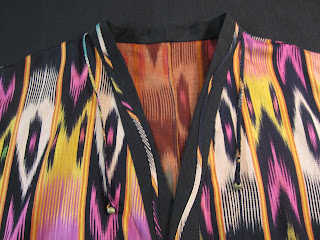IKAT
What in the world is IKAT? It is an amazing dyeing technique used to pattern textiles that employs a resist dyeing process similar to tie-dye either on the warp or weft fibres.
Ties or bindings, which resist dye penetration, are applied to the threads in the desired patterns and then the threads are dyed. These steps are done before dressing the loom. So, the weaver must know the desired pattern of the threads before preparing the loom - a most complex activity. When all the dyeing is finished the bindings or ties are removed and the threads are ready to be woven into cloth. So, the weaver must know the desired pattern of the threads before preparing the loom - a most complex activity.
How does IKAT differ from tie-dye? In tie-dye, the fabric is woven first and the resist bindings are then applied to the fabric which is then dyed.
My first sighting of IKAT was in the Guatemalan Highlands where I would saw weaving patterns with mysterious and shadowy edges. I was enchanted with the look and then amazed when I realized the intricacy and complexity of such a technique.
Later I viewed even more complex pieces of IKAT in fabrics from India, China, Thailand, Malaysia, Peru, Ecuador, Japan and last but most fascinating were the silk pieces from Central Asia along the old Silk Road.
I just had to find some of those Central Asian IKATs. So, my dear fiber friend, Ann Bowker and I (with our husbands), planned a journey along the Silk Road as far as the western border of China. We hoped to find a treasure chest full of our dream fabric in Kashgar, the largest ancient Chinese Silk Road market place. It is in the large Uyghur state of Xinjiang.
After an intensive search throughout the Kashgar area we finally found some IKAT weaving. The quality was disappointing and the colors were so bright and gaudy. Nevertheless, we brought a suitcase home to play with it,
In spite of taking great care while washing the fabric, the colors bled like crazy, but, that did seem to improve the gaudy appearance, Sewing on the fabric proved to be a pleasure. Very easy to manipulate. I chose a short jacket so that the strong colorful stripes wouldn't be too overpowering.
I am happy with the looks and feel of this fabric made into a wearable item even though it isn't the magnificent rich colored silk IKAT weaving that we had been dreaming about.
I hope you have a better idea of this incredible magical dyeing and weaving technique. To think that people have been doing this for hundreds and maybe thousands of years -- without even a computer to guide them! Let me know if you have any questions.
I'm taking a break from fiber for a few days and will be making some tribal necklaces from my beaded pieces that were all cut up by a naughty robber who helped himself to my entire ethnic collection. That's another story. Until later. nomadsally
Ties or bindings, which resist dye penetration, are applied to the threads in the desired patterns and then the threads are dyed. These steps are done before dressing the loom. So, the weaver must know the desired pattern of the threads before preparing the loom - a most complex activity. When all the dyeing is finished the bindings or ties are removed and the threads are ready to be woven into cloth. So, the weaver must know the desired pattern of the threads before preparing the loom - a most complex activity.
How does IKAT differ from tie-dye? In tie-dye, the fabric is woven first and the resist bindings are then applied to the fabric which is then dyed.
My first sighting of IKAT was in the Guatemalan Highlands where I would saw weaving patterns with mysterious and shadowy edges. I was enchanted with the look and then amazed when I realized the intricacy and complexity of such a technique.
 |
| Note the Shadowy Figures |
Later I viewed even more complex pieces of IKAT in fabrics from India, China, Thailand, Malaysia, Peru, Ecuador, Japan and last but most fascinating were the silk pieces from Central Asia along the old Silk Road.
I just had to find some of those Central Asian IKATs. So, my dear fiber friend, Ann Bowker and I (with our husbands), planned a journey along the Silk Road as far as the western border of China. We hoped to find a treasure chest full of our dream fabric in Kashgar, the largest ancient Chinese Silk Road market place. It is in the large Uyghur state of Xinjiang.
After an intensive search throughout the Kashgar area we finally found some IKAT weaving. The quality was disappointing and the colors were so bright and gaudy. Nevertheless, we brought a suitcase home to play with it,
In spite of taking great care while washing the fabric, the colors bled like crazy, but, that did seem to improve the gaudy appearance, Sewing on the fabric proved to be a pleasure. Very easy to manipulate. I chose a short jacket so that the strong colorful stripes wouldn't be too overpowering.
 |
| The Raspberry Jacket |
 |
| It's Reversible! |
 |
| View of the Back |
I am happy with the looks and feel of this fabric made into a wearable item even though it isn't the magnificent rich colored silk IKAT weaving that we had been dreaming about.
 |
| I Love the Wild One |
 |
| A Close Up View |
 |
| Guatemalan Ikat Example |
 |
| Ikat from Laos |
 |
| Another Guatemalan Ikat |
I'm taking a break from fiber for a few days and will be making some tribal necklaces from my beaded pieces that were all cut up by a naughty robber who helped himself to my entire ethnic collection. That's another story. Until later. nomadsally

